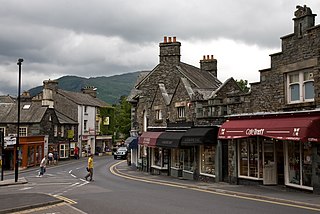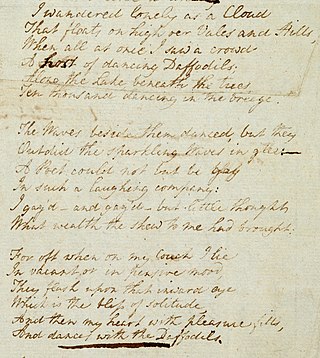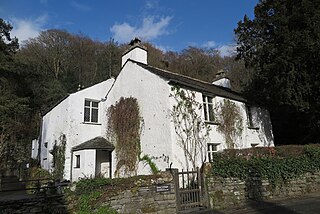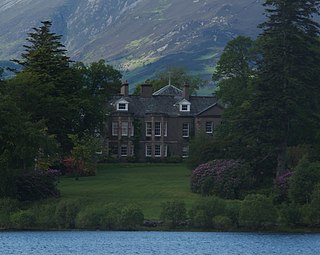
Rydal Mount is a house in the small village of Rydal, near Ambleside in the English Lake District. It is best known as the home of the poet William Wordsworth from 1813 to his death in 1850. It is currently operated as a writer's home museum.

Rydal Mount is a house in the small village of Rydal, near Ambleside in the English Lake District. It is best known as the home of the poet William Wordsworth from 1813 to his death in 1850. It is currently operated as a writer's home museum.
Wordsworth was born in Cockermouth in Cumberland in 1770, and knew the Lake District well from his childhood. He moved away to study at the University of Cambridge in 1787, and then travelled in Britain and continental Europe for 12 years. He spent over 8 years at Dove Cottage in nearby Grasmere from 1799 to 1808, but was forced to move to accommodate his growing family and many visitors. After a period in Allan Bank in Grasmere, the Wordsworths moved to Rydal Mount in 1813 which remained their home until their deaths. [1]
Both Grasmere and Windermere lakes can be seen from the hillside grounds of Rydal Mount. William designed the layout of the gardens at Rydal, and he often said that those grounds were his office as opposed to the spacious office/writing room in his house. On the high side of the grounds, tucked away from the main house, but overlooking both the grounds and the two nearby lakes, he built the "Writing Hut" where he spent most of his writing time. This hut consisted merely of a bench with a small roof, but it provided shelter from the frequent rains and escape from the house. He frequently was visited by Samuel Taylor Coleridge who would walk down from his home in Keswick.
Wordsworth died in 1850 and Mary in 1859. [2] Rydal Mount was acquired in 1969 by Mary Henderson (née Wordsworth), William's great great granddaughter. It remains in the ownership of the Wordsworth family, and has been opened to the public since 1970. Rydal Mount is a Grade I listed building. [3]

William Wordsworth was an English Romantic poet who, with Samuel Taylor Coleridge, helped to launch the Romantic Age in English literature with their joint publication Lyrical Ballads (1798).

Ambleside is a town and former civil parish in the Westmorland and Furness district of Cumbria, England. Within the boundaries of the historic county of Westmorland and located in the Lake District National Park, the town sits at the head of Windermere, England's largest natural lake. In 2020 it had an estimated population of 2596.

"I Wandered Lonely as a Cloud" is a lyric poem by William Wordsworth. It is one of his most popular, and was inspired by a forest encounter on 15 April 1802 that included himself, his younger sister Dorothy and a "long belt" of daffodils. Written in 1804, this 24 line lyric was first published in 1807 in Poems, in Two Volumes, and slightly revised in 1815.

Grasmere is a village and former civil parish, now in the parish of Lakes, in the Westmorland and Furness district of Cumbria, England, and situated in the centre of the Lake District and named after its adjacent lake. Grasmere lies within the historic county of Westmorland. The Ambleside and Grasmere ward had an estimated population of 4,592 in 2019. William and Dorothy Wordsworth, the 'Lake Poets', lived in Grasmere for 14 years and called it "the loveliest spot that man hath ever found."

The Rothay is a spate river of the Lake District in north-west England. Its name comes from Old Norse and translates literally as the red one. This has come to mean trout river. It rises close to Rough Crag above Dunmail Raise at a point about 1542 feet above sea level. Its catchment area covers Grasmere Common including Easedale Tarn, the southern flanks of Fairfield, and several of the fells to the east of Dunmail Raise, including Great Rigg, Rydal Fell, Scandale Fell and Heron Pike.

The Wordsworth Trust is an independent charity in the United Kingdom. It celebrates the life of the poet William Wordsworth, and looks after Dove Cottage in the Lake District village of Grasmere where Wordsworth and his sister Dorothy Wordsworth lived between 1799 and 1808. It also looks after the majority of the surrounding properties in the conservation area of Town End, and a collection of manuscripts, books and fine art relating to Wordsworth and other writers and artists of the Romantic period. In 2020 it introduced the brand name Wordsworth Grasmere.

Derwent Island House is a Grade II listed 18th-century Italianate house situated on the seven-acre (three-hectare) Derwent Island, Derwent Water, Keswick, Cumbria, and in the ownership of the National Trust. It is leased as a private home, but is open to the public five days a year. The interior is classical in style.

Wordsworth House is a Georgian townhouse situated in Cockermouth, Cumbria, England, and in the ownership of the National Trust. It was built in the mid-18th century. William Wordsworth was born in the house in 1770. The house is a Grade I listed building. It is open to the public as a writer's house museum from March to October each year.

Rydal Water is a small body of water in the central part of the English Lake District, in the county of Cumbria. It is located near the hamlet of Rydal, between Grasmere and Ambleside in the Rothay Valley.

Dove Cottage is a house on the edge of Grasmere in the Lake District of England. It is best known as the home of the poet William Wordsworth and his sister Dorothy Wordsworth from December 1799 to May 1808, where they spent over eight years of "plain living, but high thinking". During this period, William wrote much of the poetry for which he is remembered today, including his "Ode: Intimations of Immortality", "Ode to Duty", "My Heart Leaps Up" and "I Wandered Lonely as a Cloud", together with parts of his autobiographical epic, The Prelude.

Rydal Hall is a large detached house on the outskirts of the village of Rydal, Cumbria, in the English Lake District. It has an early nineteenth-century front facade, but includes some earlier fabric.

Rydal is a village in Cumbria, England. It is a small cluster of houses, a hotel, and St Mary's Church, on the A591 road midway between Ambleside and Grasmere.

Graythwaite Hall, in Ulverston, Cumbria in the Lake District of England is the home of the Sandys family.

White Moss House is situated at the north end of Rydal Water in the English Lake District.

St Oswald's Church is in the village of Grasmere, in the Lake District, Cumbria, England. It is an active Anglican parish church in the deanery of Windermere, the archdeaconry of Westmorland and Furness, and the diocese of Carlisle. The church is recorded in the National Heritage List for England as a designated Grade I listed building. As well as its architectural interest, the church is notable for its associations with the poet, William Wordsworth and his family, and for its annual ceremony of rushbearing.

Greta Hall is a house in Keswick in the Lake District of England. It is best known as the home of the poets Samuel Taylor Coleridge and Robert Southey.
Lakes is a civil parish in the South Lakeland District of Cumbria, England. It contains 214 listed buildings that are recorded in the National Heritage List for England. Of these, six are listed at Grade I, the highest of the three grades, 20 are at Grade II*, the middle grade, and the others are at Grade II, the lowest grade. Lakes is a large parish in the Lake District National Park containing the villages of Ambleside, Troutbeck, Rydal, Grasmere, Elterwater, and Chapel Stile, and the valleys of Great Langdale and Little Langdale. Otherwise the parish is rural, including countryside, hills and mountains. Many of the listed buildings are concentrated in the villages, with many dating from the 17th century, and others are scattered in the valleys. Most of the listed buildings are houses and associated structures, shops, farmhouses, farm buildings, bridges, public houses and hotels, and churches with items in the churchyards. Other listed buildings include a former Roman fort, an aqueduct, an AA telephone box, a market cross, and two war memorials.

Allan Bank is a grade II listed two-storey villa standing on high ground slightly to the west of Grasmere village in the heart of the Lake District. It is best known for being from 1808 to 1811 the home of William Wordsworth, but it was also occupied at various times by Dorothy Wordsworth, Dora Wordsworth, Thomas De Quincey, Samuel Taylor Coleridge, Thomas Arnold, Matthew Arnold and Canon Hardwicke Rawnsley. It is now owned by the National Trust and is open to the public.

St Mary's Church is in the village of Rydal in the Lake District, Cumbria, England. It is an active Anglican parish church in the deanery of Windermere, the archdeaconry of Westmorland and Furness, and the diocese of Carlisle. The church, built in the Gothic revival style, is situated off the A591 road between Ambleside and Grasmere and is recorded in the National Heritage List for England as a designated Grade II* listed building.

Fox Ghyll or Foxghyll, earlier Fox Gill, is a historic house near Ambleside in Cumbria, England, and is a Grade II listed building. It is a Regency building which seems to have been added to a much older house that was on the site. It was the home of many notable people including Thomas De Quincey over the next two centuries.